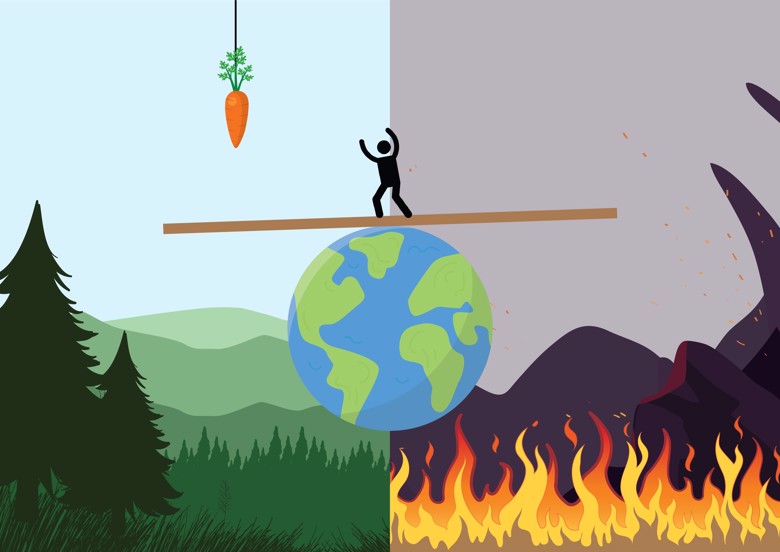It's anyone's guess what the future holds. Heck, if you were talking a virus that would bring the world to a standstill 3 years ago, or a computer the size of a sponge 20-odd years ago, it's likely you would be branded a conspiracy theorist at best, a lunatic at worst.
At this point, shaking a magic 8 ball from the 80s seems more reliable than much of the media we digest today.
With no desire of being inducted into the tin foil hat society, let's discuss the carbon landscape of freight transport and the undercurrent of regulations that will inevitably accompany the transition towards a sustainable future based on the facts we have today.
Last I checked, 9% of Americans don't believe in climate change. If you fall into that slowly depleting group I suspect you're not reading this, or you're looking to leave the comfort of that rock.
What do we know? Well, without delving too deeply into global environmental degradation, it is apparent to most that things are changing; with more frequent severe weather events and natural disasters, we are seeing massive losses of life, livable habitat, and economic hardship globally.
The Transport and Logistics industry is by no means immune to the changing environment, on the contrary, we are overexposed through the multi-modal, multi-faceted approach to shifting goods around the world. Around 90% of the world's goods travel by sea, which naturally leads to growing concerns about the impact that severe weather will have on key transport modes.
Surprisingly, environmental impacts on operations is not the leading reason businesses are measuring and reporting their carbon. Customer expectations are changing: gone are the simple days of being satisfied with goods passing 15 transaction points, traversing trucks, boats, planes, and trains, navigating the globe, and seamlessly landing on one's doorstep. Customers now want to know the ‘real cost’ of their freight: the complete carbon footprint, including the share generated during the transportation process.
Government is also driving change, enacting regulatory changes to make it legally obligatory for businesses to measure, report, and reduce their carbon emissions.
While we sit in a transitory state, between government commitment (Paris agreement, carbon 2030, 2050, etc), and legal enforcement, there are clear opportunities, not too dissimilar to the carrot and stick archetype.
The stick parallels government regulation, whilst the carrot (slowly masticating) is the competitive advantage that can be seized via early adoption of carbon reporting and reduction frameworks.
Grabbing the carbon carrot (CC) historically has been difficult. How the CC is defined may vary. We see it as a competitive advantage; offering information to customers that others currently aren't able to and being one step ahead of the stick, reaping the vegetative benefits in the process.

“Give me six hours to chop down a tree and I will spend the first four sharpening the axe.” - A Lincoln
Ignoring the antithetical virtues of tree felling, Abe is right that with any new project, adequate due diligence prior to taking action is still a good idea.
As a business, it's vital you first understand your goal or objective within the sustainability realm: that way, analysis such as reporting is targeted towards operational areas, providing detailed visibility of carbon appropriately.
Reporting specifically is a developing expectation. Recently the NZ government required 200+ of our largest companies to produce climate-related disclosures (CRD). The impact? A suite of CRD legislation is being developed in conjunction with the XRB (External Reporting Board) to frame exactly what businesses need to transparently report & reduce. The XRB is aligning with the TCFD (Task Force on Climate-related Financial Disclosures) to ensure international standards are upheld, which provides us with some additional information based on the protocols used by other countries further along this journey.
The UK is arguably one of the most progressive in this space, New Zealand and Australia's alignment of legislation with the crown provides us with some insight (places tin foil hat on head). The Climate Change Act (CCA) sets the reduction targets, but the real kicker is the legal obligation built into the targets; financial penalties for businesses who fail to adequately report and/or reduce emissions, based on the commitment category their operation falls under. This concept of financial penalties for failing to adhere to legal obligations is the tactic effectively used in the UK.
The UK’s Committee on Climate Change (CCC) ensures that reporting is evidence-based, setting standards that businesses need to adhere to and creating a level of standardisation among reporting metrics and analytics. The CCC is one of the key considered metrics used by groups such as the CCA here in NZ, to ensure levels of consistency across the board.
The aforementioned CRD is the single biggest action the government has taken, and has direct implications on business, moving us closer to the ‘stick’.
If you're legally obliged to disclose climate-related aspects of your business, and part of your business uses Transport & Logistics services, it's only natural that you expect data from your 3PL/Freight Forwarding providers. Looking ahead, it's important businesses have the capability to generate and report on this data from a customer perspective, but also from a regulatory perspective, as the government looks to ramp up the expectation.
So the question is,
Carrot,
Or
Stick?
Why not tackle both?
© Copyright 2025, Sandfield Associates Limited. All Rights Reserved. Privacy Policy